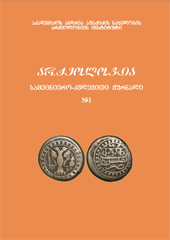SHORETI MONASTERY LAPIDARY INSCRIPTION OF BUILDING DONOR
Ключевые слова:
Samtskhe-Javakheti, Aspindza, Tori, Shoreti Monastery, Lapidary InspirationАннотация
The article discusses a study on the Shoreti monastic complex and its lapidary inscriptions, based on materials obtained by the Georgian Historical Society, the Department of Cultural History of TSU, and the Aspindziskhevi’s Scientific-Research Institute of the Georgian Caucasian Culture, History and Ethnology. Prior to the Aspindziskhevi’s expedition, no significant archeological research, documentation, or conservation efforts had been conducted on the Shoreti monastic complex. We had only scant information from historical sources, as well as the results of exploratory expeditions by prominent scholars and volunteers (from the late 19th to the 20th centuries). The Shoreti monastery complex is a cultural heritage monument of VI-XV centuries, located in Aspindza, 5-6 km southeast of Ota. The architectural structures that has been rebuilt many times, suggest that the main church was likely built on the remains of a 6th-7th centuries cultic structure. The lapidary inscriptions at the Shoreti monastery are particular significant, offering insights into the feudal house. This inscriptions confirm the feudal names and origins mentioned in the Monastery of Cross inscriptions:Saba-Nikolozi and Otari Varaza, who are considered to be founders and (sab)otars, of the descendants of the Sharo rulers (Khosrovan-Bakureans) and ancestors of the Shalikashvili feudal house. The conducted studies highlights that these complex belong to the most important cultural heritage monument of Samtskhe-Javakheti. However, the complex has not yet been fully explored from an archaeological point of view. The evidence suggests that the site has served as a place of worship since ancient times.
Загрузки
Опубликован
Выпуск
Раздел
Лицензия
Copyright (c) 2024 Archeologia

Это произведение доступно по лицензии Creative Commons «Attribution-ShareAlike» («Атрибуция — На тех же условиях») 4.0 Всемирная.




